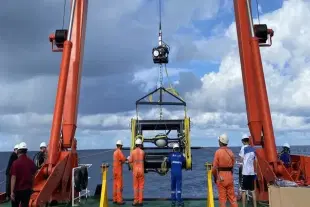Science
China's Enormous Underwater Telescope To Hunt "Ghost Particles": Here's Everything You Need To Know
Nayan Dwivedi
Oct 24, 2023, 02:47 PM | Updated Dec 14, 2023, 05:10 PM IST
Save & read from anywhere!
Bookmark stories for easy access on any device or the Swarajya app.


China is in the process of building an enormous telescope in the western Pacific Ocean designed to detect neutrinos, often called "ghost particles".
This groundbreaking telescope, the largest of its kind, is set to provide scientists with a unique glimpse into the hidden world of these elusive particles, as recently reported by Indian Express.
Understanding what neutrinos are, requires a basic grasp of atoms, the fundamental building blocks of everything with mass in our universe.
Atoms were once believed to be the smallest units of matter, but we now know they consist of even smaller particles known as subatomic particles, including protons (positively charged), electrons (negatively charged), and neutrons (having no charge).
Neutrinos, similar to neutrons, are nearly chargeless and often referred to as "ghost particles".
These minuscule particles, which are incredibly abundant in the universe, were initially considered to be without mass, but recent discoveries suggest they possess a very tiny amount of mass.
Detecting neutrinos has always been a significant challenge for scientists. They rarely interact with other particles and can only be observed when such interactions occur.
This rarity of interactions makes them difficult to study and earned them the nickname "ghost particles" since majority of them go undetected.
Although ghost particles have minimal interactions, they do occasionally interact with water molecules. This unique trait has led China to construct an underwater telescope specifically designed to detect these elusive particles.
Ghost particles, also known as "muons," can be observed when they produce flashes of light while passing through water or ice.
Advanced underwater telescopes can capture and identify these flashes of light, providing one of the few methods for studying the energy and origin of neutrinos.
Currently, the University of Madison-Wisconsin's "IceCube" telescope in the Antarctic is the largest neutrino-detecting telescope, covering an area of about 1 cubic kilometre.
However, China has ambitious plans to build "Trident" in the South China Sea, with sensors spanning an impressive 7.5 cubic kilometres.
The larger size of Trident is expected to significantly increase sensitivity, allowing it to detect a greater number of neutrinos compared to existing underwater telescopes.
Construction is already underway, and it is projected to be completed within this decade.
Neutrinos hold special significance for scientists due to their puzzling behavior, which appears to defy established laws of physics.
Their abundance in the universe adds to the mystery surrounding their nature and characteristics.
The origin of neutrinos remains uncertain, with scientists speculating they might have existed in the early universe following the big bang.
A comprehensive understanding of neutrinos is believed to hold the key to solving numerous scientific mysteries, including the enigmatic origin of cosmic rays, which are known to contain neutrinos.
Nayan Dwivedi is Staff Writer at Swarajya.





